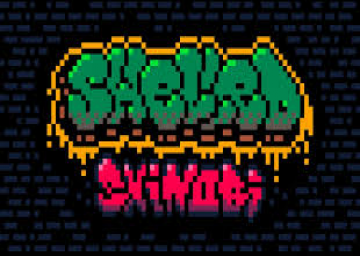A list of the definitions of currently known or otherwise invented combinations of mechanics, as well as how to perform them. Some include places good for practicing more complex mechanics. I use pixels rather than blocks in these measurements. For reference, a block in this game is 8 pixels by 8 pixels. The statistics measured in version 1.1 are similar enough to those measured in version 0.12 that they weren't written differently. Rooms are the separate areas in each zone bounded by the large 24 pixel width walls (otherwise called barricades). Fun fact to go along with this, any bottom right corner block of any barricade (including those that aren't room separators) isn't actually a wall and can easily be jumped into. Also a fair note, "stop" in this community is more often used to refer to changing directions than actually stopping flat.
shell- entering the shelled state The tortoise can move faster in this state, at 120 pixels per second (or 2 pixels per frame in version 1.1), but is unable to change directions. Acceleration while transitioning to the shelled state is slower than acceleration in the unshelled state. The tortoise's hitbox is always 8 pixels tall, even in its shelled state. The tortoise's full speed shell itself is a state, not only being shelled. The tortoise's hitbox is always 8 pixels tall, even in its shelled state. If the tortoise hits a wall in its shelled state, it'll reverse it's momentum. The tortoise can move in its shelled state without reaching the full speed state. If the tortoise is in the shelled state in liquid, even at full speed momentum, it will eventually stop the full speed state of the tortoise. If the tortoise leaves a liquid while it's in its full speed state, even if it isn't actually moving at full speed, it'll accelerate back to moving at full speed and maintain its full speed state. how to perform: press the shell button (traditionally X or V on keyboard and left or right face button on controller) with enough speed while in the unshelled state
unshell- leaving the shelled state Lets the tortoise change directions. The tortoise moves at 60 pixels per second (or 1 pixel per frame in version 1.1) in the unshelled state. The tortoise's acceleration in the unshelled state is faster than its acceleration while transitioning to the shelled state. how to perform: press the shell button (traditionally X or V on keyboard and left or right face button on controller) while in the shelled state
jump- jumping The tortoise goes into the air, reaching slightly higher than 24 pixels above its original height. It jumps at a little under 140 pixels per second against a gravity of approximately 400 pixels per second, taking approximately .35 seconds to reach its maximum height. how to perform: press the jump button (traditionally Z or C on keyboard and top or bottom face button on controller)
spring bounce (or just "jumping off a spring")- touching a spring hitbox and launching into the air The tortoise goes into the air, reaching slightly higher than 54 pixels above its original height. It jumps at approximately 208 pixels per second against a gravity of approximately 400 pixels per second, taking approximately .53 seconds to reach its maximum height. The hitbox for a spring is 8 pixels wide by 3 pixels tall relative to the tortoise's horizontal collision hitbox. A spring hitbox only launches the tortoise if it's not moving in the same direction the spring would launch it. The tortoise can hit the spring hitbox from any other direction, allowing it to bounce higher or lower based on where it hits the hitbox. how to perform: touch the hitbox for launching off a spring while moving in the opposite direction the spring would launch you
can collect (or just "collecting an item")- touching a can hitbox and collecting it The can collection hitbox is 4 pixels wide by 8 pixels tall in reference to the tortoise's horizontal wall hitbox. This means that the tortoise can collect cans from 4 blocks under them in a single full height jump. how to perform: touch the hitbox for collecting a can
button press (or just "touching a button" or "pressing a button")- touching a button hitbox in Skyline In version 1.1, the tortoise can trigger the button press hitbox with its horizontal wall hitbox 8 pixels away from the wall the button is attached to, and with its same hitbox 3 pixels downward or upward into the block the button is within, but it can't trigger the button press hitbox with its horizontal wall hitbox directly against the wall the button is attached to, or further within this same wall. In version 0.12, the tortoise can trigger the button press hitbox with its horizontal wall hitbox 10 pixels away from the wall the button is attached to, and with its same hitbox 1 pixel downward or upward into the block the button is within, and it can trigger the button press hitbox with its horizontal wall hitbox directly against the wall the button is attached to, or further within this same wall. In version 0.12, this means that the tortoise can hit a button 2 blocks above its head with a single jump. how to perform: touch the hitbox for a button press
wall jump- jumping off of the green wall sludge in Sewers The tortoise wall jumps lower than it jumps normally. The tortoise's velocity is temporarily forced away from the wall sludge it jumped off of. During this time, the tortoise can face opposite it's velocity, which allows it to enter a state known as "reverse shell." In this reverse shell state, the tortoise is in the full speed shell state, but facing away from its movement direction. how to perform: press the jump button (traditionally Z or C on keyboard and top or button face button on controller) while against green wall sludge
box break (or just "break a box")- hitting a box in Docks while shelled with momentum in order to break it When the tortoise breaks a box it leaves the box that was hit in its broken state. When a box is in its broken state, it is no longer a wall; it instead becomes a platform. The tortoise can hit a box from the bottom with shelled momentum to break the box. When the tortoise hits the left or right side of multiple boxes, the box on the top breaks. how to perform: hit a box in the full speed state, or while transitioning into the full speed state
shell stop- unshelling and then shelling again in the opposite direction The simplest input-based stop, second only to bouncing off of a wall in the full speed state. how to perform: unshell and then re-shell in the opposite direction
stop jump- unshelling mid-air, jumping in the opposite direction, and then re-shelling in mid-air An efficient way of changing directions on ledges without bouncing off a wall. In most places, this is technically slower than a perfect quick stop. However, it's rather difficult for a human controlled tortoise to perform a quick stop that's worth any time save, if not time loss. how to perform: unshell slightly before landing, then walk in the opposite direction for a bit, then jump, and finally re-shell practice spots: try stop jumping between the icons where the tortoise starts the game and the pole on the right of these
swirl stop- unshelling mid-air, jumping, and then re-shelling in mid-air in the opposite direction Similar to stop jumping, but without changing directions immediately. This lets the tortoise jump up from one ledge to another and change directions in the same motion. Only realistically useful in the final room of Skyline. how to perform: jump as you land, unshell, move in the same direction for a bit, then change directions, and finally re-shell practice spots: anywhere with a three block ledge difference, especially where the higher ledge extends less than the lower one
half hop- jumping lower than normal due to less upward velocity on coyote jumps In this definition, coyote jump refers to the fact that the tortoise can jump for a short time after it's no longer on a ledge. The tortoise can coyote jump for 5 frames after leaving a ledge, down to an approximately 13 pixel jump height. This decrease in jump height comes from the fact that the tortoise's jump adds a set upward velocity rather then resetting it. Note that the tortoise's vertical wall hitbox is only 4 pixels wide, meaning that it leaves a ledge after its feet are no longer on top of it. If the tortoise's first possible landing frame lands on a block, it will always land on this block on the same frame regardless of half hop height. The tortoise can also technically half hop in version 0.12, but it's much less defined than it can be in version 1.1. how to perform: jump slightly after leaving a ledge, with the understanding that this means after your feet leave the ledge, not your whole body practice spots: any ledge, but especially jump gaps with less than three blocks separating the ledges vertically, such as the first jumps in rooms 2 and 4 of Skyline.
quick stop- quickly stopping momentum directly after unshelling When the tortoise quick stops, its momentum stops almost instantly. It’s possible for the tortoise to quick stop facing either direction regardless of the direction it’s moving. The tortoise has to be in the full speed state in order to quick stop. If the tortoise leaves the ground it cancels any stored quick stop. Quick stops seem to be stored infinitely by the tortoise until it either leaves the ground or unshelled. The benefits of quick stops are fairly unnoticeable in version 1.1, but are quite clear in version 0.12 due to the tortoise's slower acceleration. how to perform: release a directional input (meaning at least one has to be held to begin with) so that no directional inputs are held, then press a directional key, then unshell while holding a directional input, all while grounded
edge land (under land, misland)- landing inside a platform without being pushed on top of the platform It's possible for the tortoise to land on a platform lower than the actual height of the top of the platform. Normally when this happens, the tortoise is pushed to the top of the platform. However, if it lands on the correct pixel, it just lands on the platform for a frame without being pushed back up. This pixel is about 7 pixels under the top of the platform. This means that it's possible for the tortoise to jump from 7 pixels under a platform, reducing its final jump height by 7 pixels. Combining this with a half hop can lower the tortoise's jump height even further, down to approximately 6 pixels above the top of a platform. Traditionally the tortoise jumps into the edge of a platform to do this, henceforth the name edge land. However, the tortoise can also edge land by half hopping onto a platform 2 blocks above the ledge it jumps off of. how to perform: land under the edge of a platform while moving towards the platform, making sure you're low enough to not trigger the pushing back up, or, with a third frame half hop practice spots: any ledge or 3 block high jump off of a ledge
sky clip- clipping into a wall by jumping on top of a maximum height wall in Skyline at an angle This is only possible in Skyline, because Skyline is the only zone without a ceiling wall. Fake sky clips, where the tortoise's feet don't reach into the wall, are possible anywhere, because it's vertical wall hitbox is only 4 pixels. This sort of 'sky clip' isn't actually a sky clip. Sky clips are supposed to be countered by a hitbox above the maximum height walls in Skyline that push the tortoise back out rather than letting it into the wall. However, partial sky clips abuse the fact that this hitbox doesn't reach far enough down to completely prevent the tortoise from reaching its feet into the wall. Full sky clips also abuse this hitbox by making the hitbox force the tortoise further inside the wall. This hitbox naturally pushes the tortoise to the left, but also pushes against the tortoise's momentum if it's moving enough in a direction. This allows the tortoise to move further right into the wall by moving left the frame it hits this hitbox, and an extra amount to the left by moving right the frame it hits the hitbox. how to perform: jump towards a maximum height wall in Skyline so you collide with the wall around the top corner, then if you're going for a full sky clip, move so you're moving to go back outside the wall as you hit the push-out hitbox practice spots: the first button wall, the gate wall in room 2, and the fifth button wall, as well as the bottom right corner of the gate wall in room 2 to observe the hitbox without actually clipping
box stall- breaking a box, unshelling, and then going back toward the place where the box was broken This is only possible in Docks, as Docks is the only zone with boxes. It's possible for the tortoise to box stall both in the air and on the ground. The tortoise can only box stall a box aerially if it has some sort of upward momentum when it breaks the box, otherwise it won't have enough time to make it back to the ledge it broke the box on. It's possible for the tortoise to box stall without upward momentum on the ground. It's possible to re-shell mid-air while performing an aerial box stall. how to perform: break the box, then quickly unshell and move in the direction of the box you just broke practice spots: the first box after the spring in room 2 (setup: break only the first box on the jumping platform, then run into the second box, jump while moving left, and shell quickly after jumping), both rows of boxes in room 1 of Docks work for both aerial box stalls and grounded box stalls (if you need it to be easier than the right side, try box stalling grounded on the top row from the left side before you hit the left wall again)
corner clip- clipping onto the corner of a block for a frame If the tortoise collides with a wall on the diagonal, that is, colliding with both the vertical and horizontal hitboxes on the same frame, the tortoise stays on the corner of the wall it hit for a frame longer than it's supposed to. In the unshelled state, both the tortoise's vertical and horizontal momentum stop. In the shelled state on boxes, only the tortoise's vertical momentum stops; its horizontal momentum doesn't reflect or stop. In the shelled state on regular walls, the tortoise's vertical momentum stops and its horizontal momentum reflects. It's unknown if corner clips require sub-pixel precision to perform. how to perform: hit the bottom corner of a wall with both the vertical and horizontal collision hitboxes on the same frame practice spots: the bottom corners of barricades, the first room boxes in docks
box pass- corner clipping a box to edge land on the platform the box was on This is only possible in Docks, as Docks is the only zone with boxes. It's possible that the reason a corner clip allows the tortoise to do this is because it's sub-pixel position changes on the excess frame. The tortoise can't box pass from a corner clip on a wall that isn't a box. Because of this, it would seem that box passes are only possible due to the box's transformation into a platform. It's possible to chain box passes together if there are multiple boxes on a platform in a row. how to perform: corner clip a box residing on top of a platform in the shelled state, then jump practice spots: the first room boxes in docks, top left boxes in room 2 docks, bottom right boxes in room 2 docks





